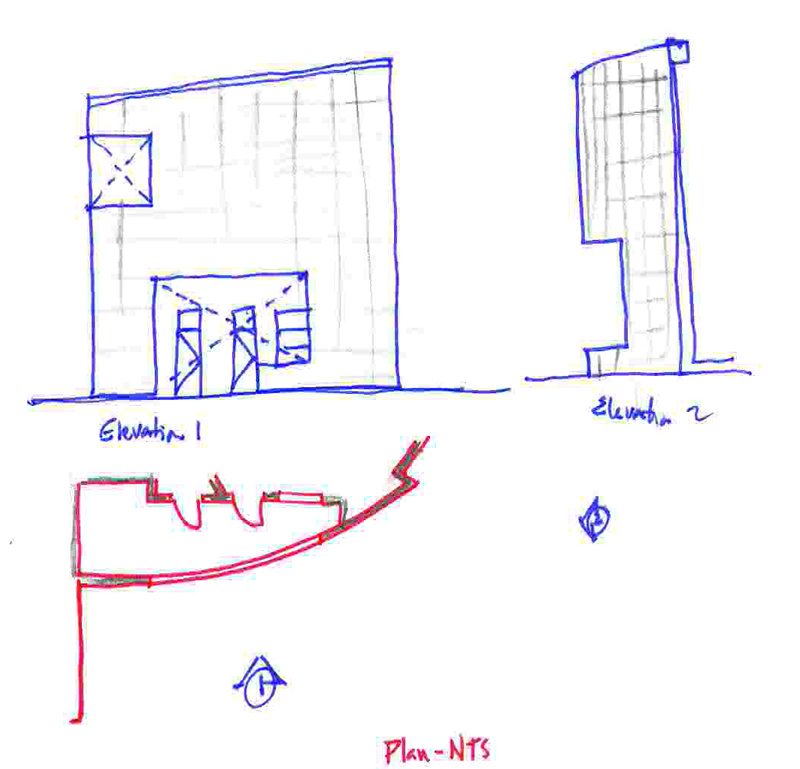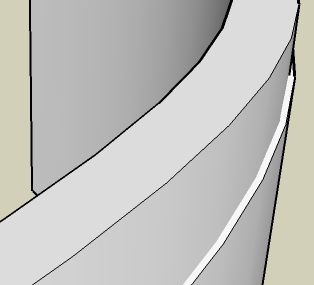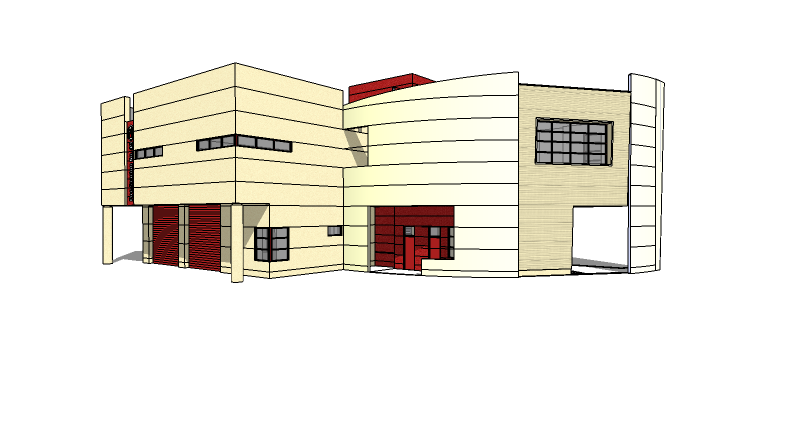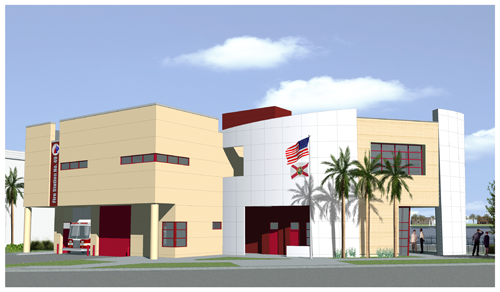Curved wall w/ variable height
-
Hey - I need some help with this one. I'm sure given the time I could figure it out but I need to figure this feature out quickly. I hope someone has done this before and has some ideas.
Basically I have a curved wall that is increases in height along the lenght of the curve - see rough sketch attached. I'l like to acheive a clean curve with the fewest joints possible.

-
-
Hi,
Here's one way of doing it, it seems to be pretty smooth but may not be the minimum size.
Bob
-
Fantastic - Thanks a lot guys!
-
@greyhead said:
Hi,
Here's one way of doing it, it seems to be pretty smooth but may not be the minimum size.
Bob
Bob,
I don’t want to spoil your fun but looking at your curved wall made me curious.
It looked so easy and for presentation it might be alright. But there is definitely something wrong like when you use the ‘Follow Me’ tool on a path that is not coplanar; that would cause a twisted cross section.In both Erics and your method the top cross section line is slanted but here the wall is getting ‘out of plumb’. This could lead to problems when relying on a straight wall construction.
See:
http://sketchup.google.com/3dwarehouse/details?mid=1c1b49900ebd37b44e97381e9f105417I can’t yet figure out why this odd behaviour occurs but unfortunately it’s a fact.
cheers,
Wo3Dan -
Neither the intersecting plan method nor follow-me will give you equal heights (90 angles at the tops of the wall). You will need to construct it manually the hard way. Note that the top surface is a sloped ramp (see the hidden lines that triangulate the surface). Follow-me in SU will always result in a twist when you are changing directions in 2 axes at once (although you won't notice this is the follow-me section is a circle like a pipe rail). In any event it will be just as hard to build in real life as it is to make in SU.
-
Paul,
About the twist when applying ‘Follow Me’ in NOT-coplanar curves I knew.
Also about the handmade stitching method. It’s the ‘out of plumb’ result of Bob Janes solution that I was pointing out and that could lead to (serious) problems when just depending on the accuracy of the construction. The top isn’t that important.
(I couldn’t believe my eyes seeing such a simple method for a curved ramp-like wall construction)cheers,
Wo3Dan -
There are some interesting things going on here - and mostly they follow from some gaps in the specification, what the designer didn't specify on the plan. Those have to be filled in somehow which means that some assumptions have to be made.
The intersection method assumes that the degree of slope is uniform along the projection of the wall, not the length of the wall itself. In the case of jfmalone's wall that isn't going to make much difference, with my example with the sharper turn it will. In effect the end of the wall, which is in the green direction will have little or no slope.
My method leaves the decision to the internal workings of SketchUp and I have no real idea how it deals with that. But it does keep the curve more or less uniform along the length of the wall.
@unknownuser said:
the top cross section line is slanted but here the wall is getting ‘out of plumb’
I hadn't noticed that, both end of the wall top are exactly at 90 degrees, but, as you say, the middle of the wall is out of plumb (see below). I'm afraid I'm going to lay that off on to the SketchUp algorithm, as far as I can work out it should be possible to lower the top surface without any lateral movement.@unknownuser said:
Neither the intersecting plan method nor follow-me will give you equal heights (90 angles at the tops of the wall).
This is tricky, the ends of the wall do have equal height - for the space in between it depends on where you choose to measure. Because it's a curve the two sides have different lengths and there are no 'right places' to choose to have the right angles. Where they should be is a design assumption - and it looks like the SketchUp algorithm is quite a long way off ideal. Your assumption that they should be equispaced is probably a much better one.Bob

-
-
For what I needed, Boofredlay's system worked great and its looking good. I have some clean-up todo but here is the WIP.

-
Man that looks great. Glad I could help.
-
-
I forgot about this posting I did. Thanks again for all the help. Here is the finished image.

-
jfmalone, that is really nice. Thanks for giving us the final.
Simon, I got the same result you did when pushing that face. Then I just erased the top and side faces so you could see the face that was passing through the curved wall. Hope that helps.
-
Dear Boofredlay, at the end, after all my attempts and some thinking about, that was the conclusion i reached to.
Hum!, elsewhere i haven't found a real Tut on Stitching. Perhaps one day, if you have little time...
-
-
Dear Remus,
Sorry i had not saw your post. Thanks for this short, simple and clear tut on STITCHING.
(we can find the ruby CurveStitcher script you've talking about here on Smustard:CurveStitcher v.2.2 by Rick Wilson )
I just would like add this tip to do manual Stitch you can find on Boofredlay's CurvedWallCut2.skp .(Second post, just clic on picture to download)

simonlebon. -
Hi All
Good topic and there is a solution.Use the [extrudeLine] to pull up a single line and intersect for slice.
Then use the [joint pushpull] (tab=keep original faces) to extrude a face.
Check out the attached
Looks flat to me.
dtr
-
It may look flat to you, but the vertical surfaces (on the right side) are not vertical, nor is the top truly horizontal. Check by turning on display edges by axis (turn on hidden geometry).
-
P Miller
You are right and my error.
SU is just plain twisted.
Top/bottom ortho view does show the out of vertical.Oh well.
dtr
Advertisement











